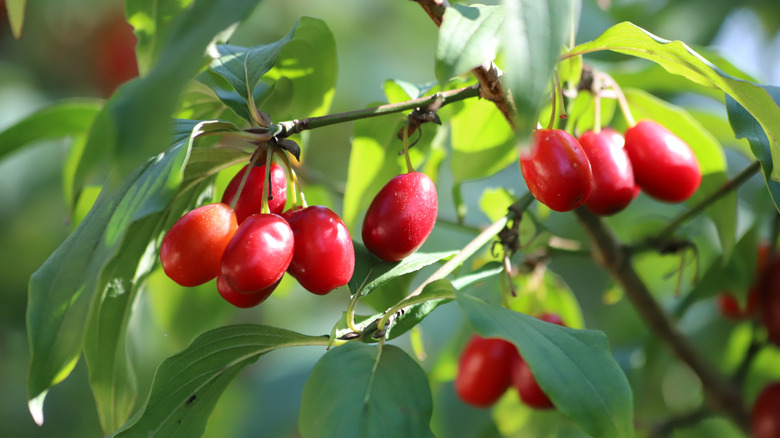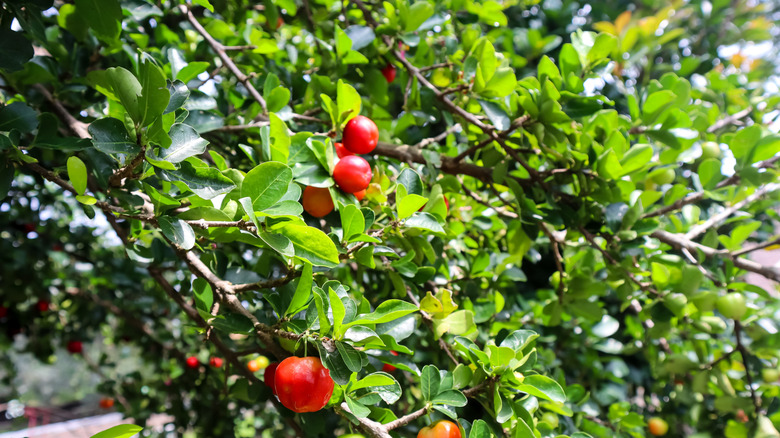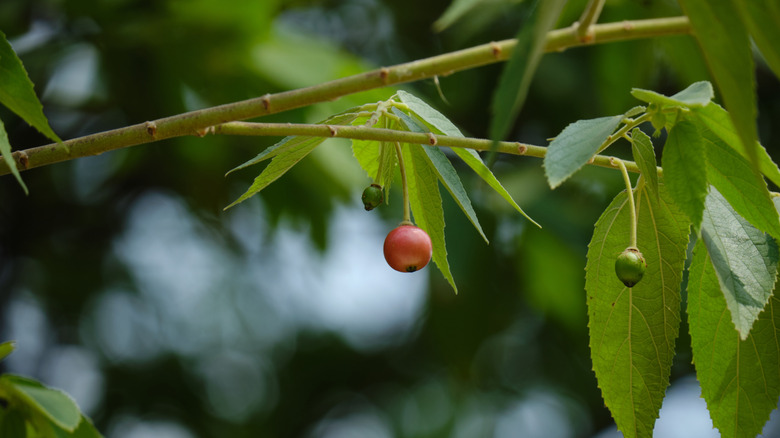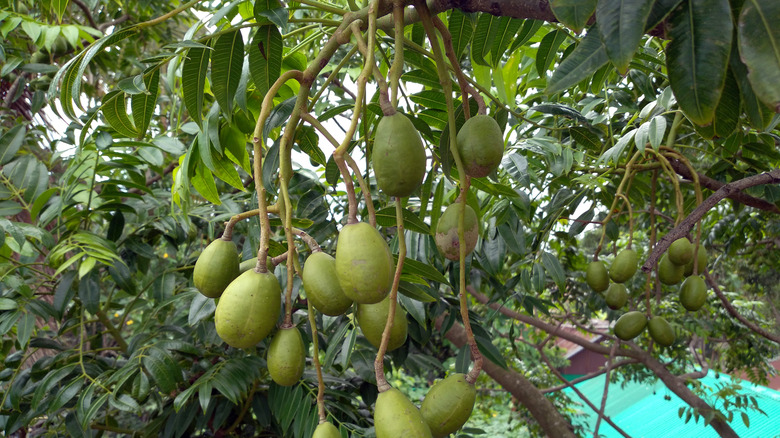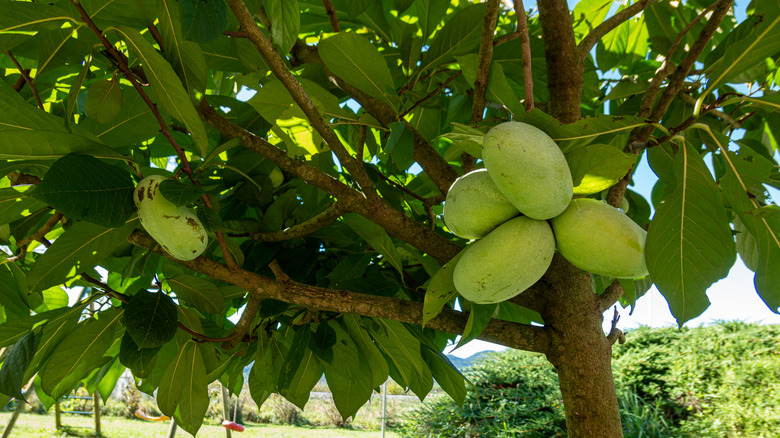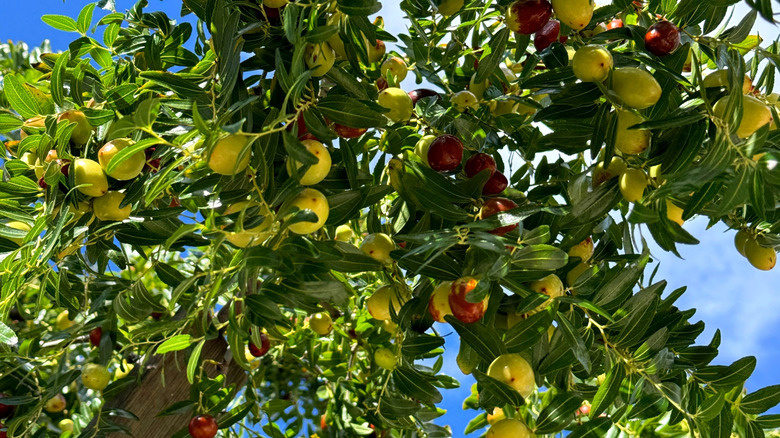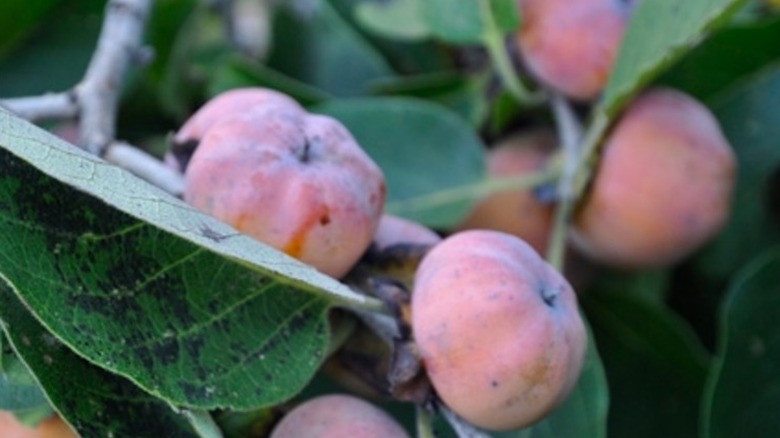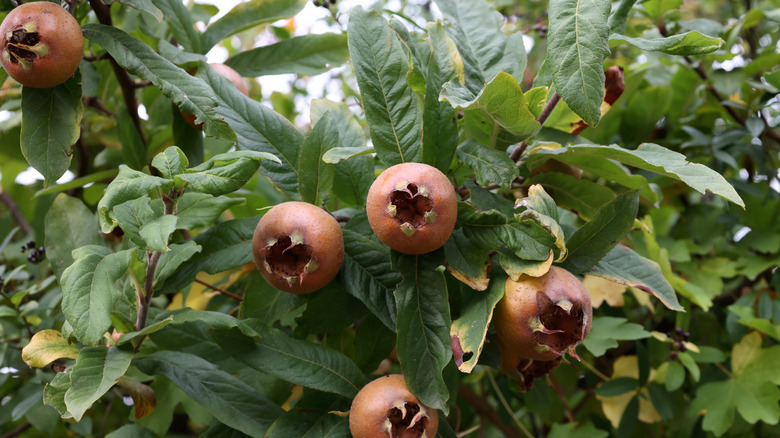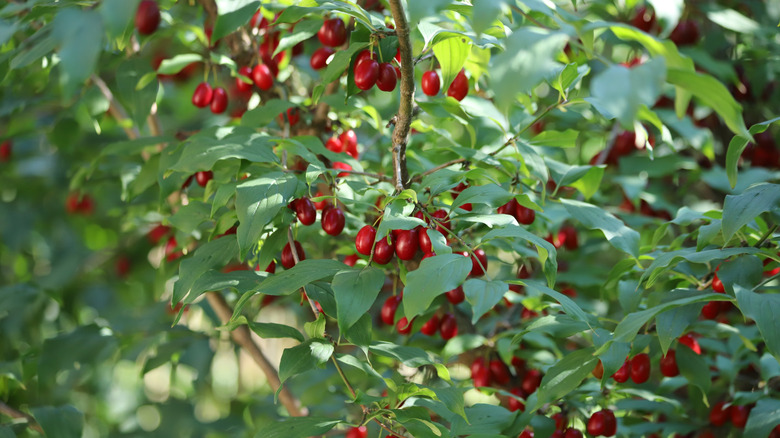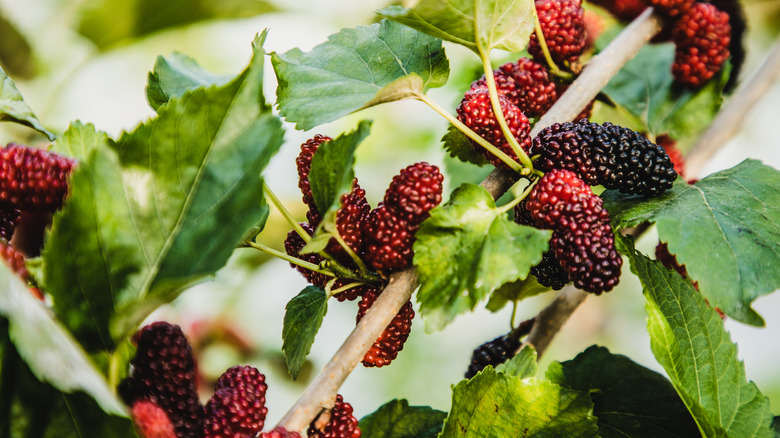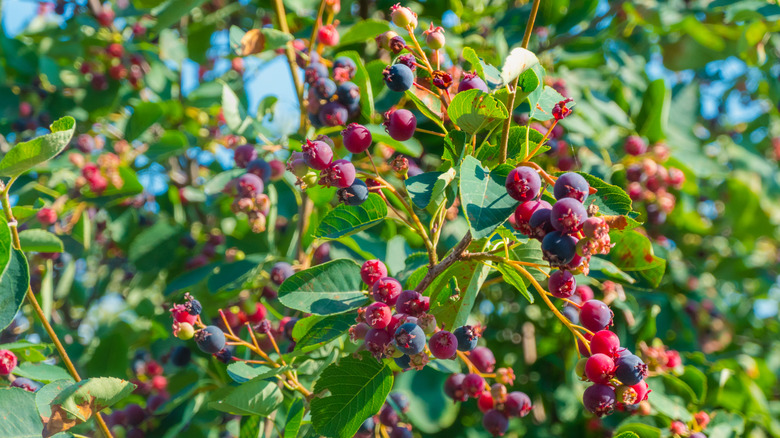Trees You Didn't Know Actually Produced Edible Fruit
It's no surprise that your collective fruit lexicon tends to be punctuated by familiar favorites like apples, cherries, plums, and nectarines — and for good reason. These are the fruits that filled your childhood lunchboxes, starred in traditional recipes, and still line supermarket shelves. Unless you were bestowed a rare or heirloom treasure by your grandma or visited farmer's markets, many of you have probably never enjoyed fruits beyond what's conventionally available. But that doesn't have to be so.
Fruit production not making commercial sense shouldn't be a reason enough to lock yourself out from this diverse world. Nor should ignorance. In fact, many fruit trees produce edible fruit, are devilishly sumptuous, and are worth planting in your yard. Native trees like mulberry, pawpaw, and serviceberry are a few classic examples. Barbados cherry, medlar, and cornelian cherry trees are other worthy examples of well-behaved, non-native fruit trees. Ready to discover fruit trees you didn't know were actually edible? Here we go! Quick note: NAFEX has a ready, state-wide compilation of nurseries that may carry rare or unusual fruits.
Barbados cherry trees produce red, tart fruits that will have you racing against birds
Before you think, "Ah, cherry?" know that Barbados cherry trees (Malpighia glabra) produce cherry-like fruits — not cherries. When borne, these fruits are round and green and gradually develop a soft, yellowish-orange or red flesh. The pulp is tangy because of ascorbic acid (Vitamin C, anyone?) and is usually consumed fresh from the tree or turned into jams and syrups. But you'll have to outrace your backyard birds. Wear long sleeves and gloves before picking, as the trees' prickly-haired leaves can be irritating. Since Barbados cherry trees begin fruiting a month after their pretty pink flowers have made a show, expect fruit from spring through fall after two years of establishment.
Also known as acerola, wild crepemyrtle, west Indian cherry, and Bajan cherry tree, these fruit trees are native to the Caribbean islands but have naturalized in south Texas, Florida, and beyond. Since they can only survive brief dips to 28 degrees Fahrenheit, they're best planted in Zones 9b to 11. Otherwise, pot them on your patio and overwinter inside through Zone 3. Barbados cherry trees are drought-resistant, but to ensure better fruit quality and keep root nematodes at bay, they should be watered regularly and offered full sun exposure. Avoid growing them in water-logged or windy sites, or their shallow root system will struggle.
The red fruits hanging on Panama berry trees may remind you of cotton candy
You might know Panama berry trees (Muntingia calabura) also as calabura, Jamaican strawberry, or jam fruit trees. They're a great tree to grow in your backyard if you have a sweet tooth since many people liken their taste to cotton candy. However, some would chalk their sweetness to be more fig-reminiscent. You can pluck the fruits when they turn red or yellow, and you can either eat them off the branch or squeeze them on salads or for jams.
Panama berry trees can be grown from seeds and will fruit 18 months later. You may alternatively propagate them using cuttings and layering. You can enjoy these tropical fruit trees year-round in Zones 9b through 11, especially in south Florida and California, though the produce can vary across seasons. These fruit trees can tolerate soil infertility, alkalinity, acidity, and drought but dislike salt and high winds. Outdoors, they may contract crown gall and Caribbean fruit flies, the latter of which is an issue in Florida and Puerto Rico. To avoid that, consider growing them indoors. Pop them into beautiful urns and place them on south-facing windows. Near-constant temperatures of 60 degrees Fahrenheit are essential for fruiting. They like it humid, so mist them intermittently, and don't forget to prune their stems to maintain a manageable size.
June plum trees provide tangy or sweet treats when potted in containers
Also known as ambarella, golden apple, and otaheite apple, June plum trees (Spondias dulcis) are another strong contender for patio or indoor containers — provided the pot is at least 12 inches wide. Although these trees shed their leaves in winter, they still look ornamental because their fruits stay on the branches (and remain good for over six months!). As for the taste, you can enjoy the fruit while it's still green and tangy, perfect for salads. Or, let it ripen to yellow, when its tanginess changes into a profile best described as a sweet blend of mango and pineapple. Just be sure to remove their seeds – they can be quite sharp.
June plum trees bear fruit through fall, spring, and summer. However, to ensure healthy growth, you must clip off lateral branches and flowers early on, until the central trunk grows about 3 feet high. This will ensure the eventual growth is sturdy enough to support the weight of its fruit. Ambarella trees require mostly full sun for maximum fruit production, and grow best outside in Zones 5 through 9. However, if you're growing one indoors near a south-facing window, keep in mind that these trees can reach up to 30 feet outdoors, which may cause them to grow root-bound in containers and lose their vitality. So, stick to dwarf cultivars that top out at 11 feet. However, because dwarf fruit trees grow and produce faster, you must thin their fruits for vigor.
Pawpaw trees grow custard-like yellow-green fruits with tropical flavors
Pawpaw (Asimina triloba) trees grow some of the biggest fruits in North America, clocking in at a pound each. This should be reason enough to bring them back into gardening parlance and in backyards. They smell extremely saccharine, are creamy to the touch, and taste like what you would expect from tropical fruits — a heady mix of mango and banana. Food connoisseurs insist they also carry tinges of pineapple, strawberry, coconut, vanilla, melon, and caramel, depending on the cultivar they tasted. When ripe in late summer or early fall, they appear as golden orbs with flashes of green. They have a short shelf-life, lasting no more than a week if picked fully ripe and refrigerated. Remove seeds (they're inedible) and de-skin before consumption.
Pawpaw trees aren't the easiest plant to grow. They have a delicate taproot that can get damaged during transplantation unless the soil is sufficiently loose and friable. Their roots must be mulched year-round to imitate their favorable conditions in the wild, where they grow best in Hardiness Zones 5 through 8. Since they usually grow as understories, you must water them generously when planted in full sun, especially during droughts. For successful fruiting, pawpaw trees require a companion for cross-fertilization. Your best bet would be to source grafted cultivars, as they grow and produce more consistently and don't require shade in initial growth years for establishment (unlike own-root stocks). 'KSU-Atwood' and 'KSU-Benson' are a few recommended varieties.
Jujube trees grow date-like fruits in wide-ranging conditions
Jujube (Zizyphus jujuba) trees look stunning when their limbs flutter in the breeze, but their real charm lies in their fruits. Unripe, the fruits appear smooth and green. Remove the stone pit to relish their apple-like taste. If not picked, they will dry on the branches, turning mahogany and wrinkled like dates, but will still offer anti-oxidants and vitamins. Use them in jams, breads, or pickles. Although gloves aren't always necessary, you may require them if your cultivar has thorny limbs. Jujube trees typically start bearing after three years of planting.
Jujube trees are quite resilient. Unlike other fruit trees, they fare well without fertilization and are easy to upkeep since they don't have any specific pests in the U.S. They continue producing fruits unabated even if they're water stressed, thanks to their deep tap roots and other moisture-retaining mechanisms. Still, to get a jujube tree to produce more fruit, it's best to keep it well-watered through droughts, maintain full sun exposure, and pair it with a companion. Even self-fruitful cultivars, such as 'Li', 'Shanxi Li,' and 'Alcalde #1' perform better in the company of other jujubes. Although jujube trees are cold hardy through -20 degrees Fahrenheit, they stop producing fruit once the mercury drops below 5 degrees Fahrenheit. While there have been some reports of jujube trees succeeding in Zones 5 to 10, they really thrive in Zones 6 to 9.
'Meader' American persimmon trees produce sweet fruits after frost
You may have heard about native persimmon trees (Diospyros virginiana), but do you know about their hybridized cultivar 'Meader'? It's self-fertile and can bear seedless fruit without being paired with its brethren. Better yet, it blooms and fruits sooner than its counterparts, usually within three years of planting. However, it's recommended to wait to eat the fruit until the first frost passes, which is when they become edible. Otherwise, the fruits will taste sour. But once they grow a deep orange, they're ready for picking and will taste sweet like dates. The fruits stay on the trees through winter, and various birds and small mammals help themselves to the sugary treats.
'Meader' is one of the best plants to have in your yard if you live in a fire-prone region, given its fire-retardant properties. You may also plant it safely in open locations exposed to winds and ice. It's cold tolerant through -25 degrees Fahrenheit, doing well in the wide range of Zones 4 through 9. Although it tolerates dry soils due to its deep tap roots, extended droughts may lead to premature fruit drop. 'Meader' can grow over 15 feet tall but can be pruned before it greens up for size containment. Since they tend to send suckers, stay on top of clipping to discourage thickets. 'Meader' typically doesn't require much fertilization, save for when it's potted, where spring and summer applications become necessary.
Medlar trees yield rosehip-shaped fruits that taste like spiced apples
Although their name and appearance may not be much to go by, medlar (Mespilus germanica) trees have been producing fruits for thousands of years and are considered an heirloom favorite, especially in Europe. Their fruits resemble rose hips, albeit sized much larger, and have a soft, buttery consistency. When you bite into them, you'll be left with an aftertaste of cranberry, apple, and cinnamon, which is surprising since these fruit trees are related to pear and hawthorn. However, to increase the sweetness and limit the acidity and tannins of the fruits, they must undergo "bletting," which is when fruits have fully ripened and are beginning to break down, but haven't quite gone bad yet. They can be cooked over fire like chestnuts or skinned for marmalades and ice creams.
If you're looking for trees that are perfect for a small garden, medlar will fit the bill as they max out at 10 feet. Given their low chill hour requirement of about 200 hours, they can be grown in Zones 4-9, though they do best in temperate regions. To ensure better fruit quality, look for grafted plants, but stake them, lest they break at the union. Moist, loam soils with high fertility are most optimal for growth, though diverse conditions are tolerated with full sun exposure.
Cornelian cherry trees produce tart, red drupes mid-summer
Love flowering dogwoods? Try out their closely related fruiting variety, aka cornelian cherry (Cornus mas). After these dogwoods bloom their heads off in early spring, they set berry-like drupes. You'll know they're up for grabs when they appear cherry red in late summer. Have them as you would tart cherries since both fruits taste similar (though some contest they've more in common with plums or cranberry), or mash them into pies and preserves. Look for cultivars like 'Elegant,' 'Jolico,' 'Bodacious,' and 'Pioneer.'
Like medlar trees, cornelian cherry trees are appropriate in small gardens where their 15-foot-frame will not overwhelm the space. Fortunately, they don't share the same ills as native dogwood species, save for anthracnose. So, invest in disease-resistant cultivars. Despite being hardy through Zone 4, it's best not to plant cornelian cherry trees in areas where temperatures can drop below -20 degrees Fahrenheit. Otherwise, their buds will drop prematurely, depriving you of any fruit. Unfussy about soils, these beautiful plants will even thrive in clay and sand, with pH levels hovering in the range of 5.5 and 7.5. Interestingly, cornelian cherry trees produce decent fruit in partial shade, but you may have to wait over four years to enjoy them.
Shipova trees produce delicious yellow fruits with buttery texture
If you know anything about grafting fruit trees, you'll know it's usually carried out within the same genus. However, shipova trees (x Sorbopyrus auricularis) are one-of-a-kind and represent a successful hybridization between European pear (Pyrus communis) and whitebeam (Sorbus aria). This helps them gain a leg up over traditional pears in terms of disease, particularly scab, and cold resistance — they're hardy in Zones 3 through 9. Also known as Bollywyller pear, shipova trees produce apricot-sized, rounded, pear-like fruits. To indicate ripeness, their flesh turns a sunkissed yellow and highly fragrant, promising flavors that are closer to a sweet apple or a meaty pear. You may also find hints of guava, mango, and marzipan.
Unfortunately, shipova trees can sit in the ground for over seven years without bearing any fruit. But since they're ornamental, especially in the fall when their silver-gray foliage turns red, you may still enjoy having them in your yard while you wait for sweet bounties. Alternatively, you may plant their dwarf cultivars like 'Baby Shipova Mt. Ash,' which grows half as tall (over 6 feet) and fruits in about three years. Shipova trees are usually self-fertile. But, they can be encouraged to produce abundant fruit by teaming alongside late-bearing pear trees, like 'Harrow Delight,' whose bloom times overlap with theirs. They don't require pruning, unless you wish to contain their size.
Mulberry trees provide sweet, blackberry-like fruits in the summer
When looking for fruit and berry trees to grow in your yard that birds love, you may have chanced upon mulberry trees (Morus spp.). However, what you may not know is that they're palatable for humans, too, and taste like honey-dipped raspberries. But you must choose the right species. Avoid any weeping forms, as they merely add ornamental beauty, sans fruit. Similarly, steer clear of white mulberries (Morus alba), especially if they're labeled invasive in your area, as they outcompete the native red mulberry trees (Morus rubra). Tartarian varieties should also be avoided, as they aren't savory. Put simply, choose red mulberries, particularly if they're native to your area (eastern U.S.), and focus on female trees, as they bear the characteristic reddish-black fruits without aggravating pollen allergies. Where space is at a premium or the conditions are arid (like California and Florida), look for black mulberry trees (Morus nigra). It's also believed that their fruits taste the best out of all mulberry varieties.
Hardy in Zones 4 to 8, mulberry trees produce fruit during summer — from July to September — with full sun. They aren't frost tender and show tolerance for gravel, shallow, alkaline, and wet soils. However, choose their site carefully. Mulberry fruits can stain the sites and may grow foul if they're left to rot, becoming messy. For this reason, they should be grown away from walkways, driveways, or pavements. Remember, mulberry fruits have a short life and must be processed into juices or jams if not consumed in a timely manner.
Serviceberry trees offer tiny pome fruits that you must get to before the summer birds
Like mulberries, serviceberry trees and shrubs (Amelanchier spp.) come in many varieties. Some, like the downy serviceberry (Amelanchier arborea), don't produce sweet-tasting fruit. For better flavor, look to varieties like saskatoon (Amelanchier alnifolia), which originates in the northwest U.S. and is widely considered to produce the best pommes. Notable cultivars include 'Smokey,' 'Northline,' 'Pembina,' and 'Honeywood.' Another great option is the apple serviceberry (Amelanchier x grandiflora), especially the 'Autumn Brilliance' cultivar, which produces sweet berries reminiscent of blueberries . These trees grow well in partially-shaded areas in Zones 4 through 8 — though some report them hardy in Zone 9 as well.
If not eaten fresh, serviceberries may be added to jams, pies, and desserts for a boost of copper and iron. They don't hold well for long and must be refrigerated to prevent over-ripening. Since they're popular with birds, harvest them early or use bird netting till you've had your fill. Make sure to pick the fruit in the morning before they grow mushy from the summer heat. Serviceberry trees typically take up to three years to start fruiting, and even though they tolerate some shade, they produce the most fruit in full sun. They're also self-fertile and tend to grow fruit every other year, with peak production in alternate seasons.
